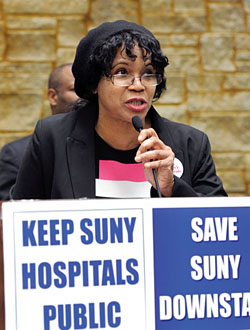
Rowena Blackman-Stroud, UUP Downstate
Chapter president and UUP treasurer, speaks
to hundreds of union members and supporters
during a rally in Albany to support
SUNY Downstate Medical Center.
Photo by El-Wise Noisette.
The executive budget once again fails to adequately fund the state's public higher education systems, union leaders say.
The proposal represents a jarring contrast between the tremendous role Governor Cuomo has assigned to the state and city university systems and community colleges in the state's economic recovery, and the reality of what these colleges and universities can actually accomplish with little support.
"Flat funding to SUNY and CUNY and a 32 percent cut in state support to the SUNY hospitals will not help our students, communities or our state as a whole," said NYSUT Executive Vice President Andy Pallotta.
"Our public colleges and universities are falling behind their counterparts in other states in several critical measures: full-time faculty lines, faculty-to-student ratio and class size. Our SUNY hospitals are on life support, especially SUNY Downstate, which is in jeopardy of closing," he said.
Union advocates will ramp up efforts in the coming days to urge lawmakers to restore the much-needed funding.
The outlook is especially bleak for the three SUNY hospitals — Upstate Medical University in Syracuse, Downstate Medical Center in Brooklyn and Stony Brook Health Sciences Center on Long Island — where the governor proposes a 32 percent cut to state support.
Unionists and community and religious leaders have been strongly advocating for months to save Downstate from closure. Hundreds of employees already have lost their jobs or have been notified of non-renewal, and several thousand more could be out of work if the state closes or privatizes the hospital. The affected workers are members of United University Professions, the NYSUT local that represents academic and professional faculty at SUNY.
Thousands of Brooklyn residents would be denied ready access to medical care if Downstate were to close.
"These hospitals rely on state support to fulfill their mission to serve everyone in need of medical care, regardless of their ability to pay. They cannot perform that mandated duty with a loss of 32 percent of their funding," UUP President Phil Smith said.
Community colleges would see their total base aid frozen at 2012-13 levels.
The executive budget proposal does include a recommendation for $5 million for "performance-based economic development funding," however. Community colleges could qualify for the incentive funding if they can prove they are working with prospective employers to offer courses and training in relevant careers.
But community college advocates point out that a relatively small pool of incentive money won't help a system that really needs a strong injection of basic operating funds.
"Any discussion of incentive funding to compel community colleges to do even more of what they are already doing — and doing very well — must be held against the backdrop of an honest discussion about how the state has failed to adequately fund community colleges for years," said Ellen Schuler Mauk, president of the Faculty Association of Suffolk Community College, a NYSUT Board member, and chair of the statewide union's Higher Education Council.
Community colleges, she noted, are supposed to be funded 40 percent by state aid, but state and county aid has steadily decreased and tuition costs have steadily increased to offset those losses.